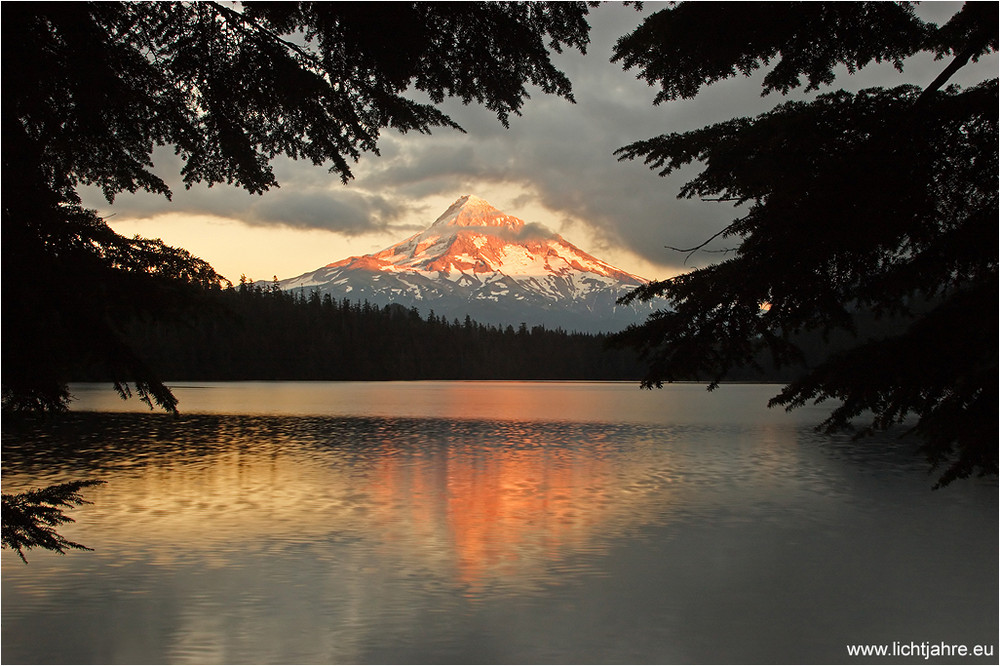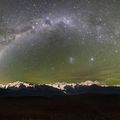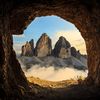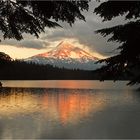Mt. Hood
Reste von Stratocumulus Bewölkung zeichnen die Konturen des Mt. Hood Vulkans durch den üppigen Regenwald von Lost Lake nach. Den Berg bedeckt eine frische Schneeauflage, die während des Durchgangs eines Tiefdruckgebietes fiel. Die Vulkane des Kaskadengebirges erstrecken sich auf 800 km in Nord-Süd Richtung entlang der Küste von Nordkalifornien bis hinauf nach Kanada. Der Grund dafür ist die entlang der Kontinentküste abtauchende Ozean-platte. Sämtliche Gipfel waren während der Eiszeit stark vergletschert. Auch heute noch reichen manche Gletscher bis in die Wälder hinein. Die Erosion formt aus bereits erloschenen Vulkanen rasch zerklüftete Gipfel. Dagegen lassen perfekte kegelartige Vulkangipfel darauf schließen, dass diese sich nur im Ruheschlaf befinden und während der letzten 10.000 Jahre mehrfach aktiv waren. Die explosive Natur dieser Vulkane liegt in ihrer Magmenzusammen-setzung begründet. Siliziumreiche Magmen stammen aus dem Anteil geschmolzener wasserreicher Ozean-sedimente sowie der Granitumgebung in der Erdkruste.
August 2008
Canon 20D, Canon 10-22mm, f/16, 1 Sek, 100 ASA, Stativ
Mehr Information unter
www.lichtjahre.eu
Where Geoscience Meets Art - Die Ästhetik der Geowissenschaft
Ein Projekt, das die Schönheit der Natur dokumentiert
und zum Verständnis der Geowissenschaften beiträgt
----------------------------------------------------------------------------------------
During sunset low level scattered stratocumulus clouds are contouring the silhouette of Mt. Hood’s stratovolcano in the lush forest surrounding Lost Lake. The mountain is covered with fresh summer snow from a low pressure system. The Cascade Range volcanoes are aligned in a north-south direction for about 500 miles (800 km) from southern British Columbia in Canada to northern California as a consequence of converging plate boundaries. All peaks were heavily glaciated during the last ice age and still carry large glaciers that extend far down the slopes. Glacial erosion eroded extinct volcanoes into jagged peaks. In contrast, the perfect cone and smooth profile of Mt. Hood reveals that the volcano is still active and hence showed activity during and since the last ice age. The ejected material during short but violent explosive cycles counteracted the erosive forces of the ice. The explosive nature of these volcanoes is due to their magma composition. The silica-rich magma originates from the fraction of molten wet ocean floor sediments and the residence time of the magma in a silica-rich granite surrounding of the Earth’s crust.
August 2008
Canon 20D, Canon 10-22mm, f/16, 1 sec, ISO 100, tripod
More information:
www.lichtjahre.eu
Where Geoscience Meets Art
A project that documents Nature's beauty
and enhances understanding of geosciences














Prantl Christian 09/12/2011 17:18
Umrahmt Tolles FotoGruss Christian Prantl
Stefan Rippel 06/03/2011 12:21
einfach wunderbar !Stephan WINKLER 15/02/2010 19:51
Eine gelungene Naturaufnahme !Sie hätte mehr Bemerkungen verdient.
VG
Stephan
Doreen und Bernd Ma. 29/06/2009 11:56
Klasse Aufnahme,sehr schönes Licht auf dem Berg!LG B&D